Data Analysis and Forecasting
VerifiedAdded on 2022/12/28
|12
|1090
|26
AI Summary
This report discusses the use of tools of central tendency in data analysis and forecasting. It covers the formulation of tables and graphs, computation of mean, median, mode, range, and standard deviation, and the use of linear forecasting models. The relevance of these tools in decision making is also explored. Study material and solved assignments on data analysis and forecasting are available at Desklib.
Contribute Materials
Your contribution can guide someone’s learning journey. Share your
documents today.
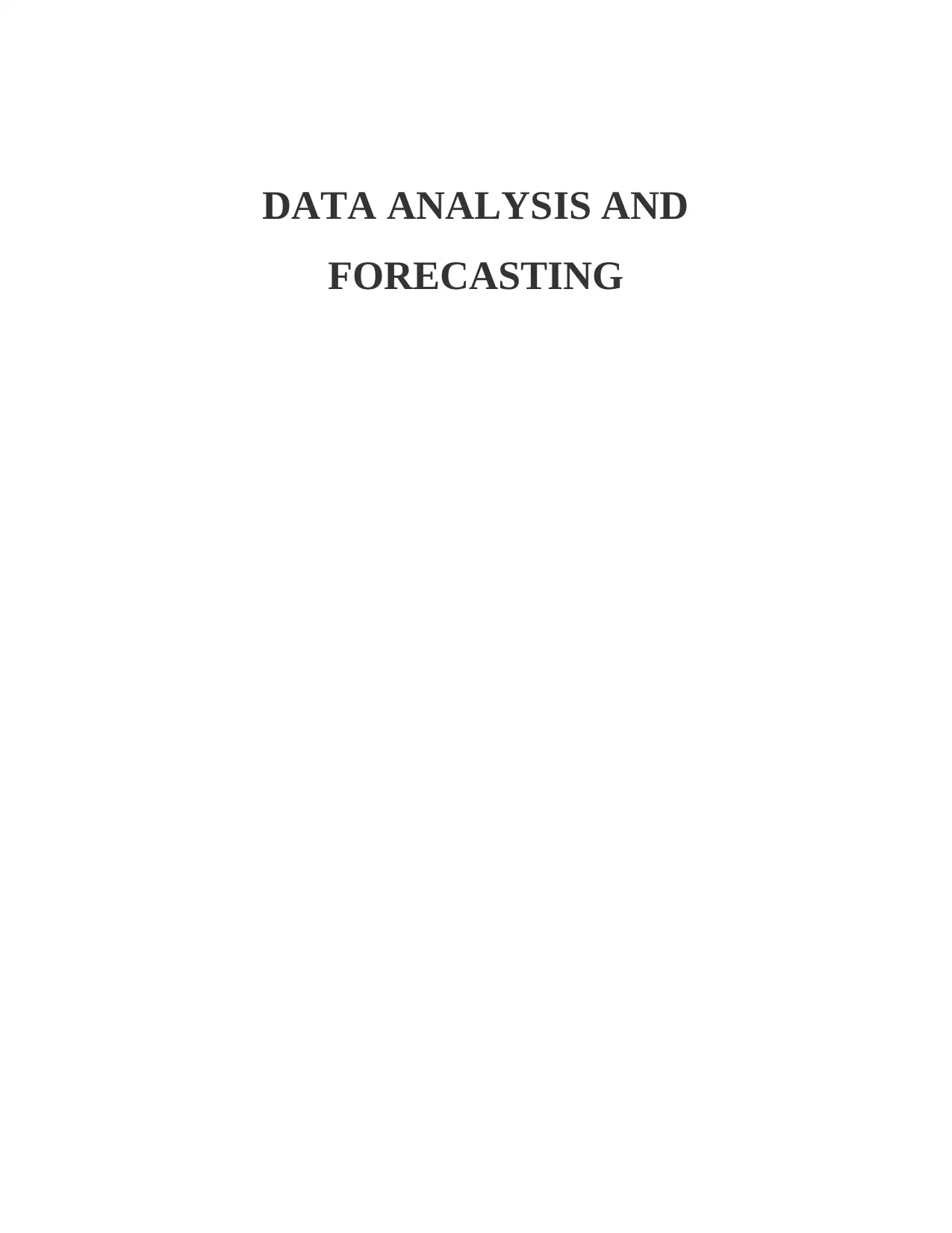
DATA ANALYSIS AND
FORECASTING
FORECASTING
Secure Best Marks with AI Grader
Need help grading? Try our AI Grader for instant feedback on your assignments.
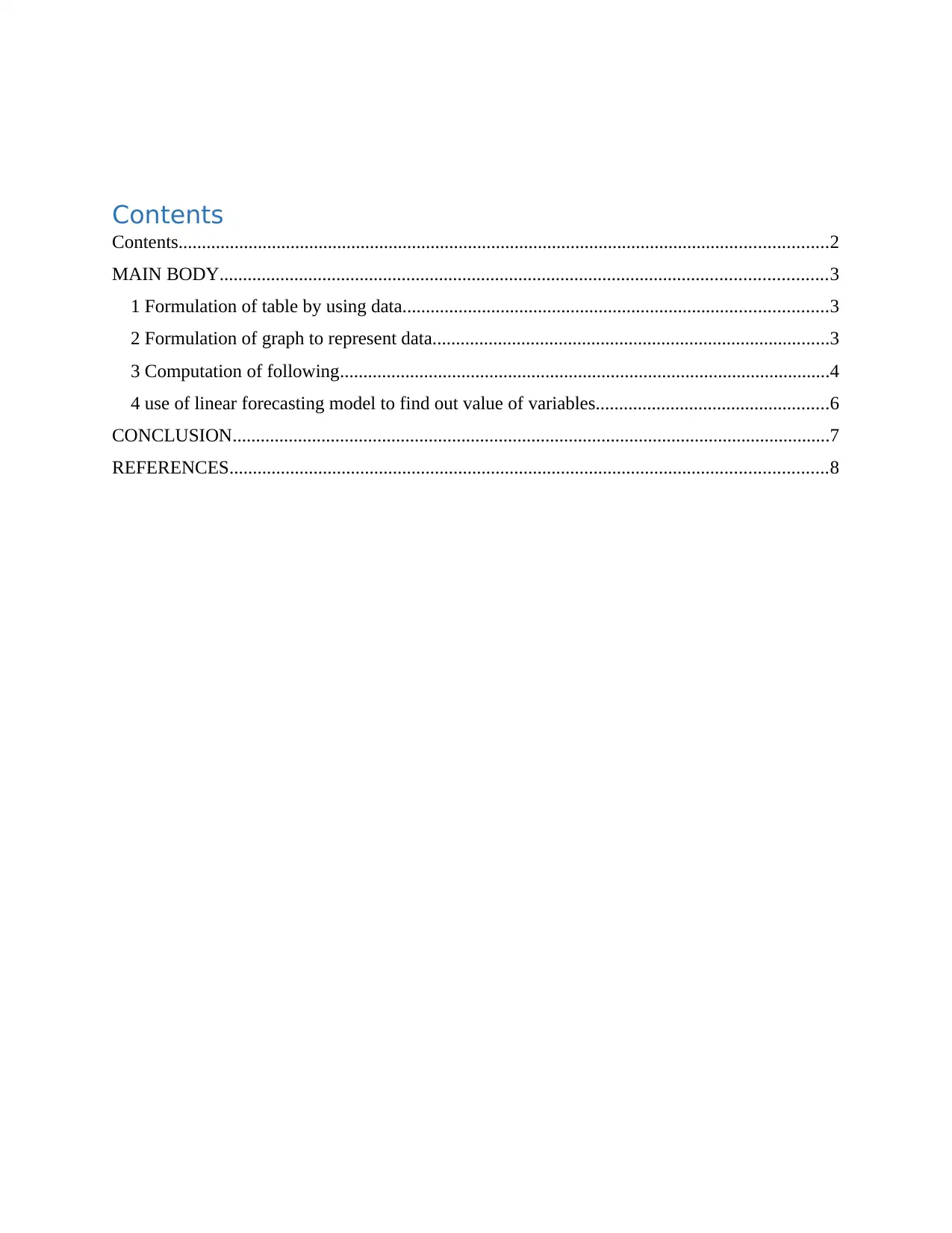
Contents
Contents...........................................................................................................................................2
MAIN BODY..................................................................................................................................3
1 Formulation of table by using data...........................................................................................3
2 Formulation of graph to represent data.....................................................................................3
3 Computation of following.........................................................................................................4
4 use of linear forecasting model to find out value of variables..................................................6
CONCLUSION................................................................................................................................7
REFERENCES................................................................................................................................8
Contents...........................................................................................................................................2
MAIN BODY..................................................................................................................................3
1 Formulation of table by using data...........................................................................................3
2 Formulation of graph to represent data.....................................................................................3
3 Computation of following.........................................................................................................4
4 use of linear forecasting model to find out value of variables..................................................6
CONCLUSION................................................................................................................................7
REFERENCES................................................................................................................................8
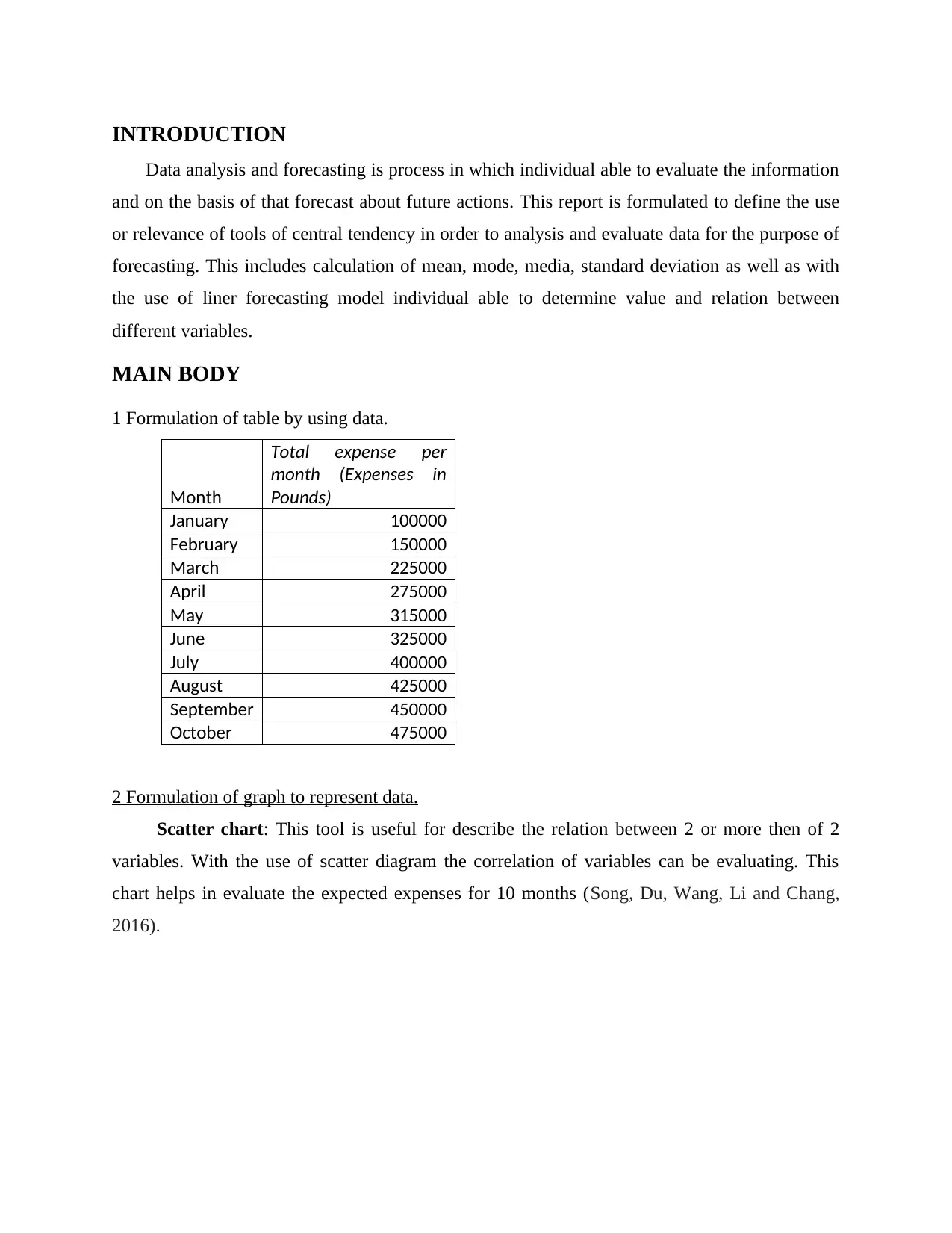
INTRODUCTION
Data analysis and forecasting is process in which individual able to evaluate the information
and on the basis of that forecast about future actions. This report is formulated to define the use
or relevance of tools of central tendency in order to analysis and evaluate data for the purpose of
forecasting. This includes calculation of mean, mode, media, standard deviation as well as with
the use of liner forecasting model individual able to determine value and relation between
different variables.
MAIN BODY
1 Formulation of table by using data.
Month
Total expense per
month (Expenses in
Pounds)
January 100000
February 150000
March 225000
April 275000
May 315000
June 325000
July 400000
August 425000
September 450000
October 475000
2 Formulation of graph to represent data.
Scatter chart: This tool is useful for describe the relation between 2 or more then of 2
variables. With the use of scatter diagram the correlation of variables can be evaluating. This
chart helps in evaluate the expected expenses for 10 months (Song, Du, Wang, Li and Chang,
2016).
Data analysis and forecasting is process in which individual able to evaluate the information
and on the basis of that forecast about future actions. This report is formulated to define the use
or relevance of tools of central tendency in order to analysis and evaluate data for the purpose of
forecasting. This includes calculation of mean, mode, media, standard deviation as well as with
the use of liner forecasting model individual able to determine value and relation between
different variables.
MAIN BODY
1 Formulation of table by using data.
Month
Total expense per
month (Expenses in
Pounds)
January 100000
February 150000
March 225000
April 275000
May 315000
June 325000
July 400000
August 425000
September 450000
October 475000
2 Formulation of graph to represent data.
Scatter chart: This tool is useful for describe the relation between 2 or more then of 2
variables. With the use of scatter diagram the correlation of variables can be evaluating. This
chart helps in evaluate the expected expenses for 10 months (Song, Du, Wang, Li and Chang,
2016).
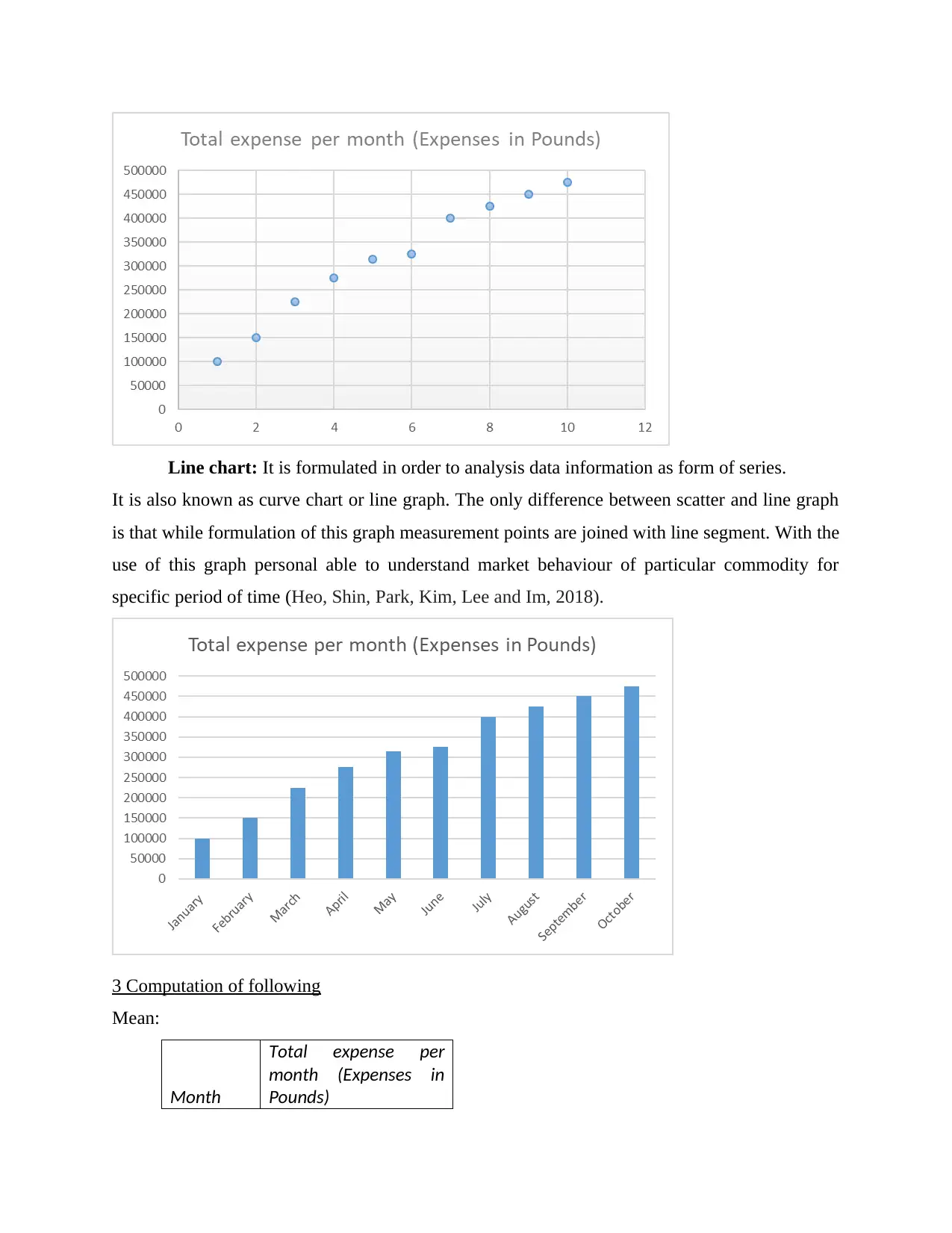
Line chart: It is formulated in order to analysis data information as form of series.
It is also known as curve chart or line graph. The only difference between scatter and line graph
is that while formulation of this graph measurement points are joined with line segment. With the
use of this graph personal able to understand market behaviour of particular commodity for
specific period of time (Heo, Shin, Park, Kim, Lee and Im, 2018).
3 Computation of following
Mean:
Month
Total expense per
month (Expenses in
Pounds)
It is also known as curve chart or line graph. The only difference between scatter and line graph
is that while formulation of this graph measurement points are joined with line segment. With the
use of this graph personal able to understand market behaviour of particular commodity for
specific period of time (Heo, Shin, Park, Kim, Lee and Im, 2018).
3 Computation of following
Mean:
Month
Total expense per
month (Expenses in
Pounds)
Secure Best Marks with AI Grader
Need help grading? Try our AI Grader for instant feedback on your assignments.
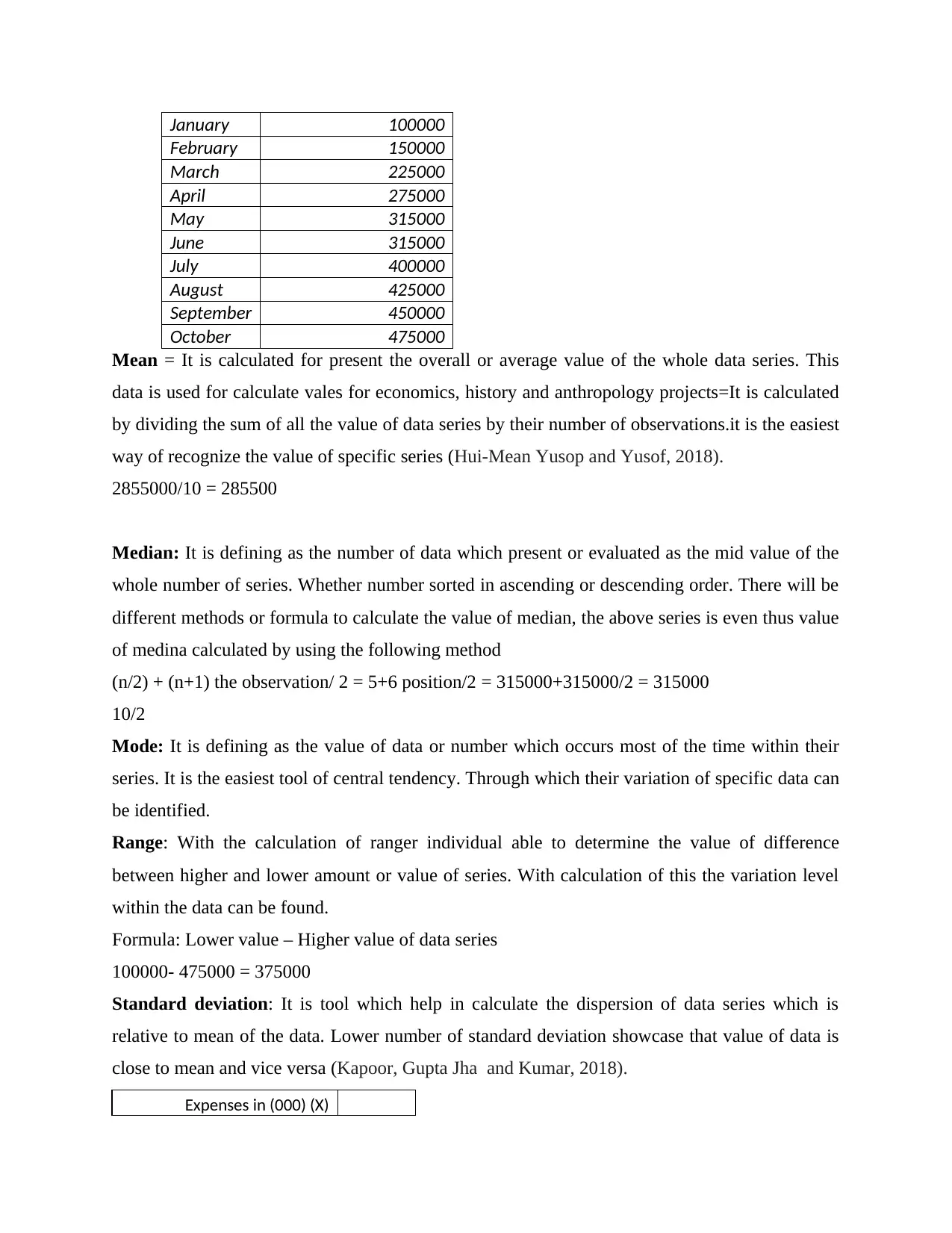
January 100000
February 150000
March 225000
April 275000
May 315000
June 315000
July 400000
August 425000
September 450000
October 475000
Mean = It is calculated for present the overall or average value of the whole data series. This
data is used for calculate vales for economics, history and anthropology projects=It is calculated
by dividing the sum of all the value of data series by their number of observations.it is the easiest
way of recognize the value of specific series (Hui-Mean Yusop and Yusof, 2018).
2855000/10 = 285500
Median: It is defining as the number of data which present or evaluated as the mid value of the
whole number of series. Whether number sorted in ascending or descending order. There will be
different methods or formula to calculate the value of median, the above series is even thus value
of medina calculated by using the following method
(n/2) + (n+1) the observation/ 2 = 5+6 position/2 = 315000+315000/2 = 315000
10/2
Mode: It is defining as the value of data or number which occurs most of the time within their
series. It is the easiest tool of central tendency. Through which their variation of specific data can
be identified.
Range: With the calculation of ranger individual able to determine the value of difference
between higher and lower amount or value of series. With calculation of this the variation level
within the data can be found.
Formula: Lower value – Higher value of data series
100000- 475000 = 375000
Standard deviation: It is tool which help in calculate the dispersion of data series which is
relative to mean of the data. Lower number of standard deviation showcase that value of data is
close to mean and vice versa (Kapoor, Gupta Jha and Kumar, 2018).
Expenses in (000) (X)
February 150000
March 225000
April 275000
May 315000
June 315000
July 400000
August 425000
September 450000
October 475000
Mean = It is calculated for present the overall or average value of the whole data series. This
data is used for calculate vales for economics, history and anthropology projects=It is calculated
by dividing the sum of all the value of data series by their number of observations.it is the easiest
way of recognize the value of specific series (Hui-Mean Yusop and Yusof, 2018).
2855000/10 = 285500
Median: It is defining as the number of data which present or evaluated as the mid value of the
whole number of series. Whether number sorted in ascending or descending order. There will be
different methods or formula to calculate the value of median, the above series is even thus value
of medina calculated by using the following method
(n/2) + (n+1) the observation/ 2 = 5+6 position/2 = 315000+315000/2 = 315000
10/2
Mode: It is defining as the value of data or number which occurs most of the time within their
series. It is the easiest tool of central tendency. Through which their variation of specific data can
be identified.
Range: With the calculation of ranger individual able to determine the value of difference
between higher and lower amount or value of series. With calculation of this the variation level
within the data can be found.
Formula: Lower value – Higher value of data series
100000- 475000 = 375000
Standard deviation: It is tool which help in calculate the dispersion of data series which is
relative to mean of the data. Lower number of standard deviation showcase that value of data is
close to mean and vice versa (Kapoor, Gupta Jha and Kumar, 2018).
Expenses in (000) (X)
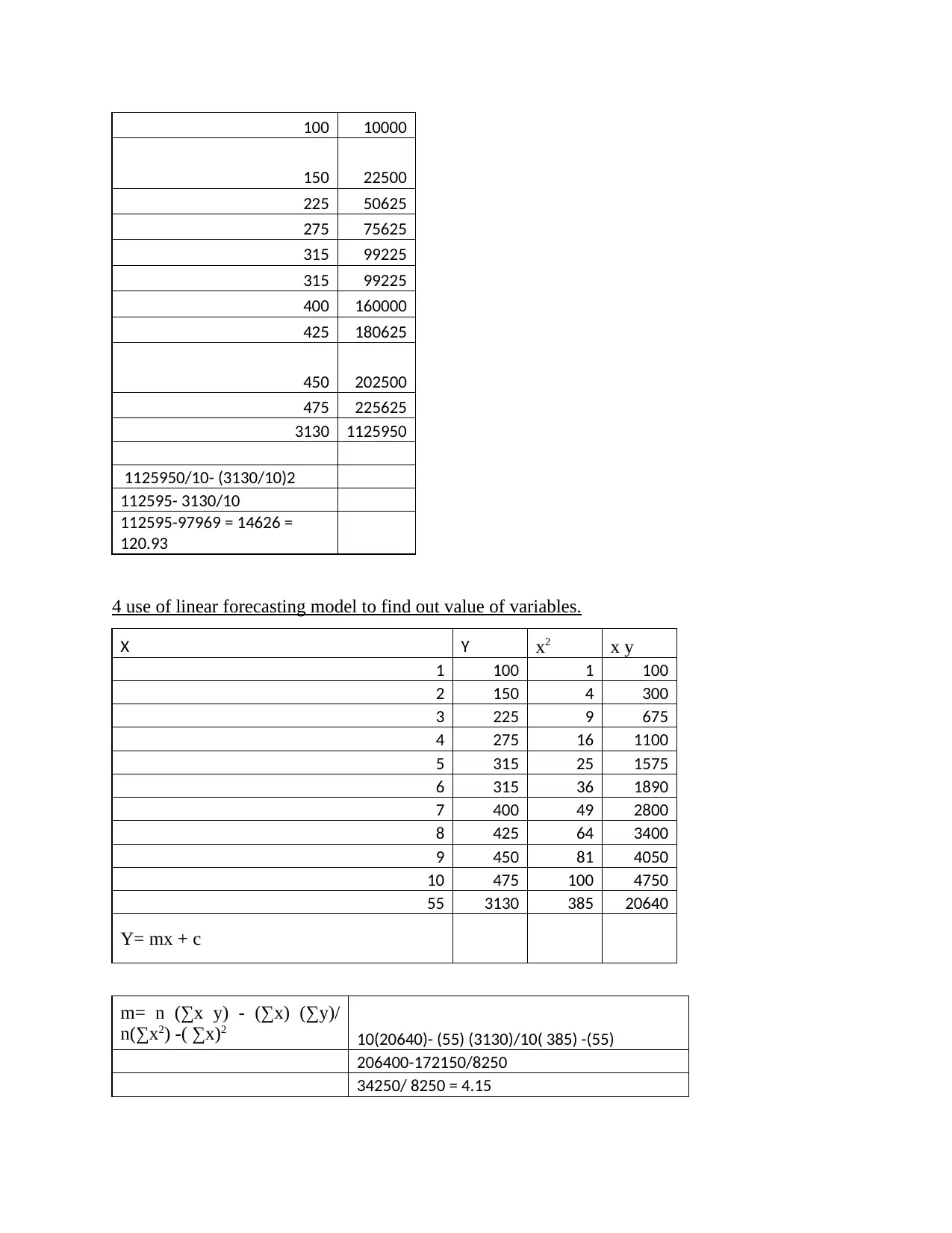
100 10000
150 22500
225 50625
275 75625
315 99225
315 99225
400 160000
425 180625
450 202500
475 225625
3130 1125950
1125950/10- (3130/10)2
112595- 3130/10
112595-97969 = 14626 =
120.93
4 use of linear forecasting model to find out value of variables.
X Y x2 x y
1 100 1 100
2 150 4 300
3 225 9 675
4 275 16 1100
5 315 25 1575
6 315 36 1890
7 400 49 2800
8 425 64 3400
9 450 81 4050
10 475 100 4750
55 3130 385 20640
Y= mx + c
m= n (∑x y) - (∑x) (∑y)/
n(∑x2) -( ∑x)2
10(20640)- (55) (3130)/10( 385) -(55)
206400-172150/8250
34250/ 8250 = 4.15
150 22500
225 50625
275 75625
315 99225
315 99225
400 160000
425 180625
450 202500
475 225625
3130 1125950
1125950/10- (3130/10)2
112595- 3130/10
112595-97969 = 14626 =
120.93
4 use of linear forecasting model to find out value of variables.
X Y x2 x y
1 100 1 100
2 150 4 300
3 225 9 675
4 275 16 1100
5 315 25 1575
6 315 36 1890
7 400 49 2800
8 425 64 3400
9 450 81 4050
10 475 100 4750
55 3130 385 20640
Y= mx + c
m= n (∑x y) - (∑x) (∑y)/
n(∑x2) -( ∑x)2
10(20640)- (55) (3130)/10( 385) -(55)
206400-172150/8250
34250/ 8250 = 4.15
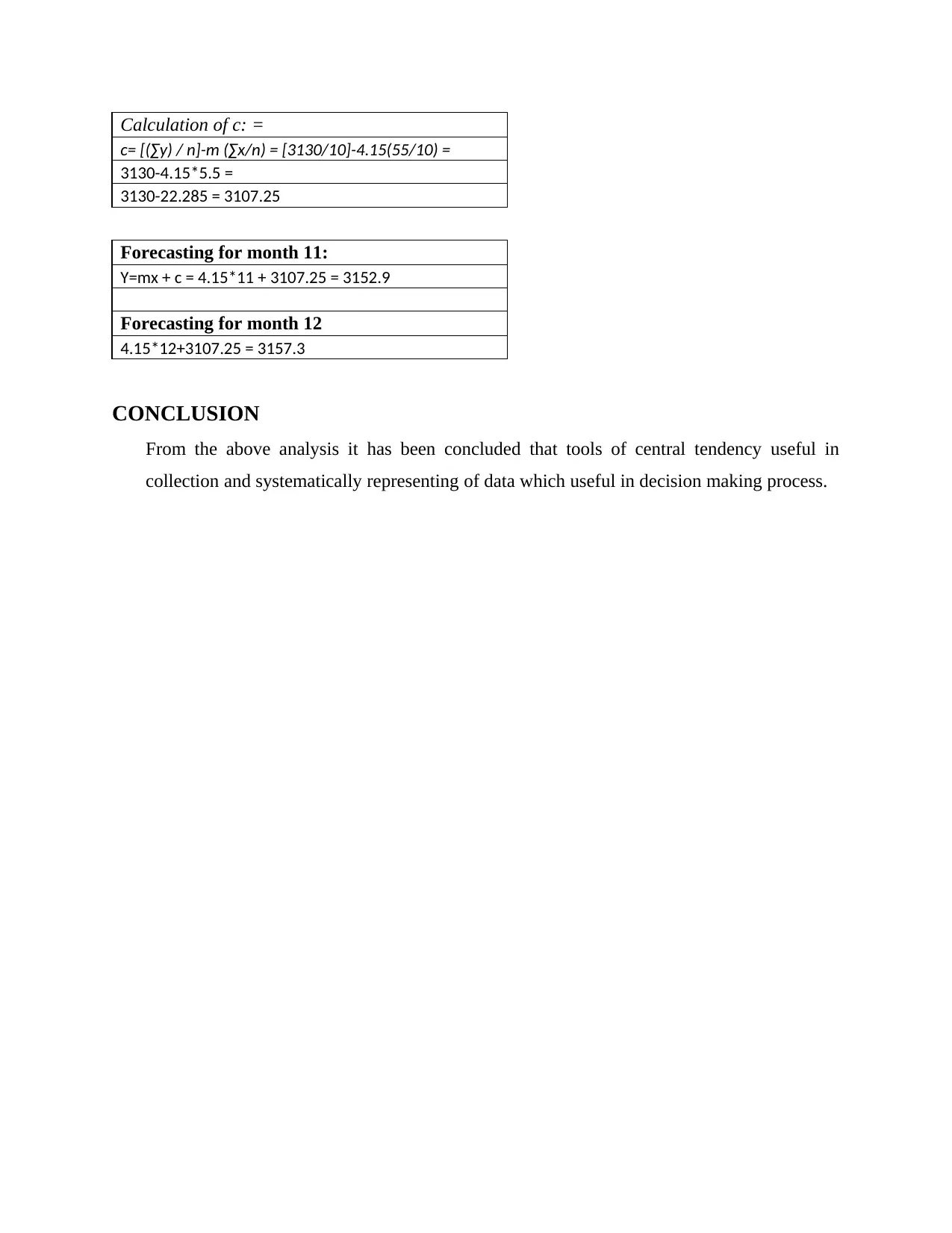
Calculation of c: =
c= [(∑y) / n]-m (∑x/n) = [3130/10]-4.15(55/10) =
3130-4.15*5.5 =
3130-22.285 = 3107.25
Forecasting for month 11:
Y=mx + c = 4.15*11 + 3107.25 = 3152.9
Forecasting for month 12
4.15*12+3107.25 = 3157.3
CONCLUSION
From the above analysis it has been concluded that tools of central tendency useful in
collection and systematically representing of data which useful in decision making process.
c= [(∑y) / n]-m (∑x/n) = [3130/10]-4.15(55/10) =
3130-4.15*5.5 =
3130-22.285 = 3107.25
Forecasting for month 11:
Y=mx + c = 4.15*11 + 3107.25 = 3152.9
Forecasting for month 12
4.15*12+3107.25 = 3157.3
CONCLUSION
From the above analysis it has been concluded that tools of central tendency useful in
collection and systematically representing of data which useful in decision making process.
Paraphrase This Document
Need a fresh take? Get an instant paraphrase of this document with our AI Paraphraser
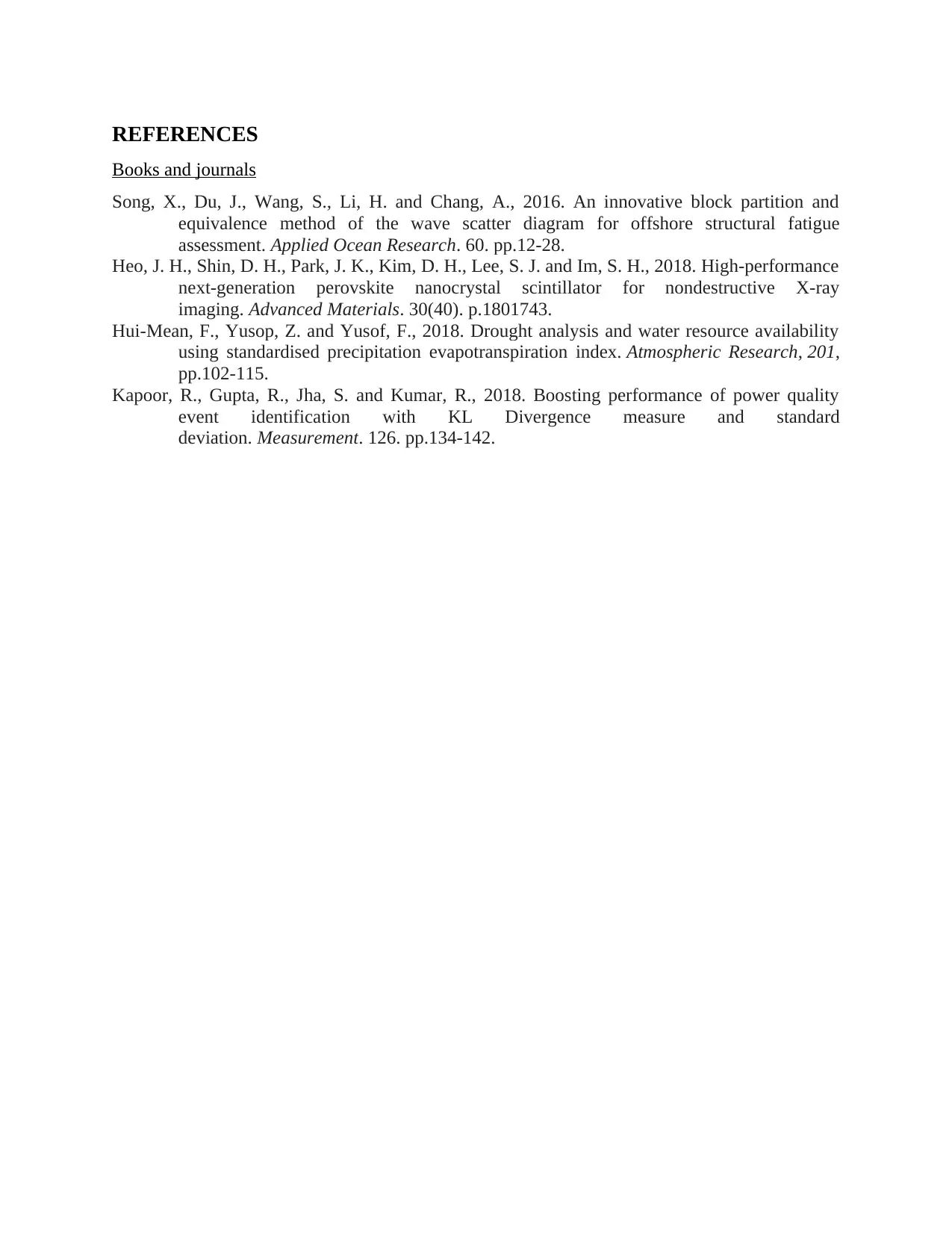
REFERENCES
Books and journals
Song, X., Du, J., Wang, S., Li, H. and Chang, A., 2016. An innovative block partition and
equivalence method of the wave scatter diagram for offshore structural fatigue
assessment. Applied Ocean Research. 60. pp.12-28.
Heo, J. H., Shin, D. H., Park, J. K., Kim, D. H., Lee, S. J. and Im, S. H., 2018. High‐performance
next‐generation perovskite nanocrystal scintillator for nondestructive X‐ray
imaging. Advanced Materials. 30(40). p.1801743.
Hui-Mean, F., Yusop, Z. and Yusof, F., 2018. Drought analysis and water resource availability
using standardised precipitation evapotranspiration index. Atmospheric Research, 201,
pp.102-115.
Kapoor, R., Gupta, R., Jha, S. and Kumar, R., 2018. Boosting performance of power quality
event identification with KL Divergence measure and standard
deviation. Measurement. 126. pp.134-142.
Books and journals
Song, X., Du, J., Wang, S., Li, H. and Chang, A., 2016. An innovative block partition and
equivalence method of the wave scatter diagram for offshore structural fatigue
assessment. Applied Ocean Research. 60. pp.12-28.
Heo, J. H., Shin, D. H., Park, J. K., Kim, D. H., Lee, S. J. and Im, S. H., 2018. High‐performance
next‐generation perovskite nanocrystal scintillator for nondestructive X‐ray
imaging. Advanced Materials. 30(40). p.1801743.
Hui-Mean, F., Yusop, Z. and Yusof, F., 2018. Drought analysis and water resource availability
using standardised precipitation evapotranspiration index. Atmospheric Research, 201,
pp.102-115.
Kapoor, R., Gupta, R., Jha, S. and Kumar, R., 2018. Boosting performance of power quality
event identification with KL Divergence measure and standard
deviation. Measurement. 126. pp.134-142.


Secure Best Marks with AI Grader
Need help grading? Try our AI Grader for instant feedback on your assignments.


1
1 out of 12
Related Documents
Your All-in-One AI-Powered Toolkit for Academic Success.
+13062052269
info@desklib.com
Available 24*7 on WhatsApp / Email
![[object Object]](/_next/static/media/star-bottom.7253800d.svg)
Unlock your academic potential
© 2024 | Zucol Services PVT LTD | All rights reserved.





